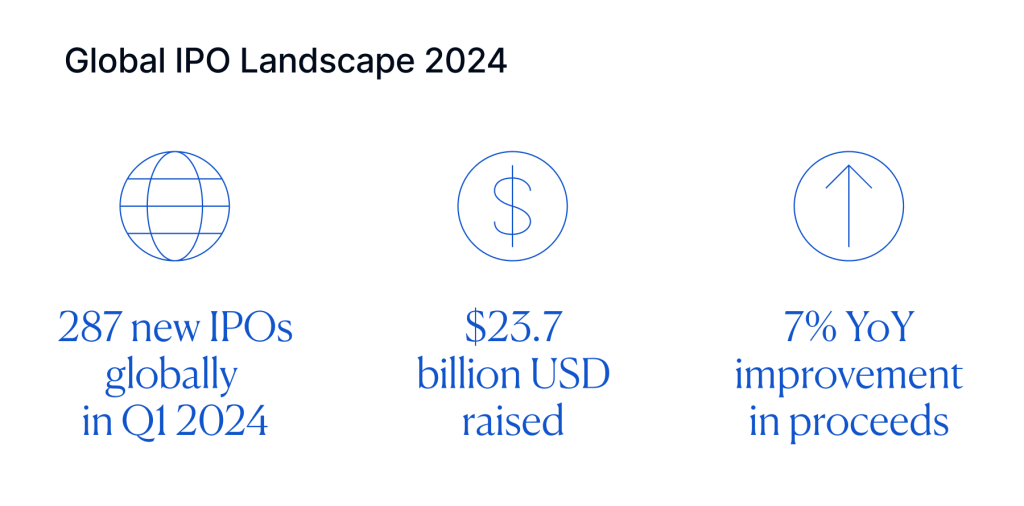
For many companies, an initial public offering (IPO) is seen as a pinnacle event.
According to the latest data for Q1 2024, there were 287 new IPOs globally. These IPOs raised a cumulative total of 23.7 billion USD. This marks a 7% improvement year-over-year in proceeds.
However, not all IPOs go as planned. When an IPO fails, it can be quite disheartening. But failure isn’t final. It shouldn’t be the reason a company gives up on its goals.
Even highly valued startups can recover and succeed after a failed IPO attempt.

The Statistics Behind IPO Failures
The IPO arena has experienced a serious decline since the dot-com bubble. For instance, in 1996, over 700 companies in the USA went public, but this number dwindled to just 105 by 2016.
This phenomenon is global. Research from Herbert Smith Freehills indicates that the number of IPOs in Australia dropped so severely in 2023 that they marked the lowest level since record-keeping began in 2016 due to market uncertainties, inflation, and higher interest rates.
Research also shows the percentage of “broken” IPOs (where the stock closes below the offering price on the first trading day) in the USA rose from 25% in 2021 to 37% in 2022. This is the highest level in recent years.
The fall of well-known companies like WeWork shows the consequences of inflated valuations. Initially valued at 47 billion USD before its IPO attempt, it suffered a dramatic reduction to below 12 billion USD when investors pulled out. WeWork subsequently withdrew its IPO, and two years later, the company filed for bankruptcy.

Common Causes of IPO Failures
- Lack of Planning: A successful IPO requires careful planning and execution. Companies often fail due to inadequate preparation.
- Misjudging Market Conditions: Timing is everything. The market’s interest in new stocks can change quickly, and misjudging this can lead to poor performance.
- Overvaluation: Setting an unrealistic valuation can deter investors. This can lead to a disappointing IPO.
- Operational Issues: Underlying business problems can become more apparent once a company goes public. This may discourage potential investors as well.
Learning from Recent IPO Failures
It’s often helpful to learn through examples. Let’s examine some IPO failures from recent history and what we can learn from them.
Lucy Scientific Discovery (Canada, 2023)
Lucy Scientific Discovery, an early-stage psychedelics manufacturing company, faced some serious challenges post-IPO. Despite its initial promise, the company’s stock declined by 99.9% due to concerns about its business model and market acceptance of psychedelic drugs. By the end of July 2024, Lucy Scientific Discovery’s stock price had fallen from 4 USD to 0.0011 USD.
Market acceptance and clear business models are particularly important for IPO success. Could a stronger alignment between business strategy and market expectations have changed the outcome?
Surf Air Mobility (USA, 2023)
Surf Air Mobility, an electric aviation company, aimed to change regional air travel for the better but struggled post-IPO. The stock, which debuted with a reference price of 20 USD in July 2023, fell by 98.4% by July 2024 due to skepticism about the viability of its business model and high operational costs.
Viable business models and cost management will always be important. Surf Air Mobility could have improved its IPO outcome by demonstrating a clear path to profitability and managing operational expenses more effectively.

Rebounding After a Failed IPO
Rebounding from a failed IPO is challenging, but it is possible with the right strategies. Companies must be willing to adapt and be agile, seek alternative funding sources, and sometimes implement cost-cutting measures. The journey from unicorn to phoenix requires resilience and strategic pivots.
One preventive option is to do a technical listing, where there is no public offering when listing the shares. This gives the current owners – and the company – a tool for future funding via offerings or a slow exit for the current owners. This way, the price point is automatically set based on market expectations, without the risk of incorrect pricing.
Solar Foods will demonstrate this approach with its planned technical listing on the Nasdaq First North Growth Market Finland in the third quarter of 2024.

It’s worth noting that even the most successful companies have faced setbacks. What matters is not the setback itself, but how a company responds to it.
About the Author
Mikael Stelander, a leading Nordic executive search consultant, founded Stanton Chase Helsinki in 2005 and serves as its Managing Partner. He also currently serves as the Global Functional Leader for Private Equity.
Mikael’s tenure includes roles as Stanton Chase’s Vice President EMEA (2012-2017) and Global Practice Leader for Technology (2007-2011).
He specializes in global C-level searches for the technology and private equity industries. His expertise also encompasses management assessments, culture assessments, and board services.
How Can We Help?
At Stanton Chase, we're more than just an executive search and leadership consulting firm. We're your partner in leadership.
Our approach is different. We believe in customized and personal executive search, executive assessment, board services, succession planning, and leadership onboarding support.
We believe in your potential to achieve greatness and we'll do everything we can to help you get there.
View All Services